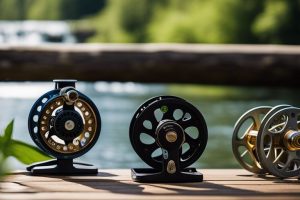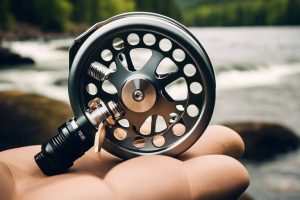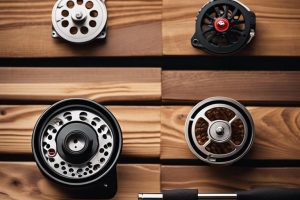Reels built for heavy-duty fishing are an important part of your angling arsenal. When facing tough conditions and the relentless pull of larger fish, you need equipment that doesn’t falter. Choose fly reels designed for resilience and performance under pressure, offering the durability and reliability needed to face rugged environments. In this guide, we will explore how to select the right fly reel, ensuring your fishing experience is not only successful but also satisfying.
Choosing the Right Materials
Durable Frames and Spools
To withstand the rigors of heavy-duty fishing, your fly reel must be crafted from tough materials. Look for frames and spools made from either high-grade aluminum or carbon fiber. Aluminum, particularly when it’s treated and anodized, offers unparalleled strength while remaining lightweight. Carbon fiber, on the other hand, provides a unique balance of rigidity and minimal weight, ideal for hours of casting without fatigue. The construction should be solid; fusion bonded or machined reels ensure that you can take on rough conditions without fear of structural failure.
Further, consider the design of the reel. A sealed drag system, integrated into the spool and frame, prevents debris from working its way into the mechanism. This feature not only enhances durability but assures smooth operation when you’re battling the biggest fish. By focusing on both material and design integrity, you can choose a fly reel that stands up to the challenges of the toughest fishing environments.
Corrosion-Resistant Finishes
Right from the start, you should recognize the importance of corrosion resistance in your fly reel. Materials that can endure both freshwater and saltwater conditions are paramount. Look for reels that boast anodized finishes or are coated with advanced composites. These surfaces help protect against the relentless onslaught of salt, which can quickly degrade lesser products.
Durable finishes don’t just protect your reel—they extend its lifespan substantially. Regular exposure to water and UV rays can wear down the protective layers on your gear, leading to premature wear and functionality issues. By investing in reels with high-quality corrosion-resistant finishes, you ensure your equipment not only survives but thrives in harsh environments. Opting for a finish that resists scratches and is easy to clean is also a smart choice. Your investment in solid materials and finishes will pay off when you’re reeling in your prize catch, knowing your gear is up to the task, regardless of the conditions.
Reel Size and Capacity
Some aspects of fly fishing don’t change, like the need for robust tackle that can withstand the rigors of heavy-duty use. Pertaining to reel size and capacity, opting for a larger reel can be your best bet. Larger reels not only hold more line but also distribute weight evenly, providing the muscle you need during those lengthy battles with big fish. A heavier reel balances out the rod, helping you maintain control and power as you fight against the currents and the strength of larger species.
Larger Reels for Heavier Fish
One of the critical decisions you’ll face is the size of your reel, especially when targeting larger fish. If you plan to pursue species like tarpon, salmon, or big lake trout, you’ll need a reel capable of holding significant amounts of line and backing. Larger reels provide the necessary drag system to tire out a robust fish, reducing the chances of a break-off when you’re in the heat of the moment. With the right size, you gain confidence, knowing that your gear can handle whatever nature throws at you.
Line Capacity and Backing Options
The line capacity of your reel is vital. It dictates how much backing you can fit along with the fly line, which is imperative when you’re targeting larger fish. A full-capacity reel allows for greater line retrieval speeds and ensures that you have ample backup if a fish makes a powerful run, a common occurrence with hefty catches. Choose a reel with ample line capacity to accommodate varying size requirements, particularly if you plan to fish in waters with sudden deep drops or aggressive species.
For instance, if you’re fishing for bluefish or large pike, your reel should ideally hold 200 yards or more of 30-pound backing. This ensures you won’t get spooled if a fish makes a long run. Additionally, consider braided lines for backing due to their thin diameter, allowing you to maximize your reel’s capacity without sacrificing strength. Pay attention to both line and backing; they’re your lifelines, keeping you connected even when the going gets tough.
Drag Systems for Heavy-Duty Fishing
You know that a reliable drag system can spell the difference between a triumphant catch and a lost trophy. For heavy-duty fishing, mechanical drags provide both consistency and strength. These systems feature a series of discs or pads that create friction, allowing you to control the line’s release during a fierce fight. This setup is straightforward and dependable, making it ideal for situations where the stakes are high and the fish are tough. Whether you’re wrestling with a sizable tarpon or battling a stubborn steelhead, mechanical drags deliver the performance required in challenging conditions.
Mechanical Drags for Consistency
Drag systems built on mechanical principles shine with their predictability. Once set, they respond uniformly under pressure. You’ll find this reliability crucial when facing the big ones; every second matters when combating powerful fish. The precise control of a mechanical drag enables you to adjust your strategy mid-fight, lending you the upper hand against stubborn foes. With a well-tuned drag, you can feel the struggle of your quarry, ensuring you stay engaged in the fight without question.
Adjustable Drag Settings for Versatility
Adjustable drag settings can offer a level of versatility that is important for heavy-duty fishing. With a swift twist or pull, you can fine-tune your reel to match the conditions of the day. You may encounter situations that demand lighter drag when targeting smaller species, or perhaps you should crank it down hard when fending off aggressive fish. This adaptability ensures you remain prepared for any scenario that plays out on the water.
With an adjustable drag, every size fish presents an opportunity, not a challenge. It grants you the ability to be nimble and responsive, adjusting pressure as the fight unfolds. This feature is particularly beneficial when working with various line types, braided or mono, as their strengths demand different treatments. Your reel becomes an extension of your instinct, allowing you to thrive even when the currents become unpredictable.
Features for Handling Heavy Fish
All serious anglers know that when it comes to landing heavy fish, the right features in your fly reel can make all the difference. As you gear up for your next big catch, understanding the important components designed for durability and performance is key. Fly reels tailored for tough fishing conditions must possess attributes that can endure heavy use while delivering the reliability you need. If you’re on the lookout for sturdy Fly Fishing Reels, consider the following features that will serve you well on the water.
Stronger Gear Trains and Bearings
Bearings are critical for smooth operation, especially when you’re up against fierce resistance from a stubborn fish. High-end fly reels often incorporate stainless steel or ceramic bearings to ensure they remain corrosion-resistant and functional under extreme conditions. A robust gear train complements these bearings, offering the torque needed to turn the reel effectively even with substantial strain. This combination bolsters your ability to maintain control during the fight, allowing you to apply consistent pressure without failing.
Moreover, the design of these gear trains contributes to your reel’s efficiency and longevity. With gears that are either larger or more finely crafted, you maximize the power transfer, providing that all-important advantage when a mighty fish decides to take off. Investing in a reel with a strong gear train and quality bearings means you’re preparing for battle—one that can withstand the rigors of heavy-duty fishing.
Large Arbor Designs for Quick Retrieval
Arbor size is a vital aspect of a fly reel’s design, particularly for anglers targeting hefty game fish. A large arbor allows you to retrieve line quickly, minimizing the time you lose while a fish runs. This increased retrieval speed can be a game changer when the fish is running towards the cover or making desperate jumps that jar your gear. The faster you can get line back onto your reel, the better your chances of maintaining tension and controlling the catch.
Retrieval isn’t just about speed; it’s about precision and efficiency. Large arbor designs also balance well with modern lines, reducing memory and tangles, which proves invaluable during those intense moments. When you’re dealing with hard-fighting species, every second counts; therefore, a reel that offers you quick, effortless retrieval gives you a distinct edge. Equip yourself with the right tools, and you’ll find that nature’s challenges become just another chapter in your fishing adventures.
Saltwater and Freshwater Considerations
Despite the beauty of fishing in both salt and freshwater, each environment demands its own unique set of gear. The challenges posed by saltwater—corrosion, the relentless pull of powerful fish, and harsh conditions—require equipment that can withstand the rigors of the elements. When dicking out a fly reel for heavy-duty fishing, you must consider materials, drag systems, and overall construction to ensure your gear stands up to the test. This is especially important if you’re pursuing species like tarpon or marlin that are known for their strength and size.
Reels Designed for Saltwater Use
Considerations for saltwater reels start with materials. You need reels constructed from anodized aluminum or stainless steel, as these resist rust and degradation. Sealed drag systems and precise engineering are crucial, too. These features keep saltwater out, ensuring smooth operation when you’re fighting a fish that could take you into the backing if you’re not careful. Your reel should not only endure the fight but also the elements, with durability at the forefront of its design.
Freshwater Reels with Corrosion Protection
For freshwater fishing, the priority shifts slightly but remains critical. Choose reels that incorporate corrosion-resistant features, especially if you fish near brackish waters or where humidity is a factor. Many freshwater reels are designed to endure splashes and moisture but should still include protective coatings and seals. Look for models with high-quality materials that balance weight and strength, so you’re not burdened as you cast for hours.
To enhance your experience in freshwater, consider reels that utilize advanced technologies to provide long-lasting protection against wear and tear. Many reels come with multi-layered finishes or hydrophobic coatings that repel water. Your choice should not only ensure reliable function but also longevity, allowing you to focus on the catch without worrying about corrosion from environmental elements. Investing in a quality freshwater reel with robust corrosion protection allows you to fish with confidence, knowing your gear can handle the demands of your adventures.
Balancing Reel Weight and Performance
Once again, you face the challenge of finding a fly reel that champions both durability and performance. In the harsh realities of heavy-duty fishing, every gram can make a difference, especially when you’re out in the elements, battling the forces of nature. Choosing a reel that withstands tough conditions requires a careful balance between weight and functionality. Reels that are too heavy can wear you down, making all-day casting a chore rather than a pleasure. This makes selecting the right materials and design paramount. For those looking to invest in quality, Hardy Fly Fishing Reels offer a blend of sturdiness and lightweight performance, allowing you to fish longer without fatigue.
Lightweight Reels for All-Day Casting
Performance is vital when you’re on the water all day. Lightweight reels reduce hand fatigue and allow for more agile casting techniques, which is vital when targeting elusive fish. When choosing a reel, look for options crafted from durable yet lightweight materials. This includes high-grade aluminum or composite materials that can handle wear while keeping the overall weight down. The last thing you want is gear that hinders your movement or makes you uncomfortable, especially as the hours drag on under the sun.
High-Capacity Reels for Heavy-Duty Fishing
Balancing strength with design leads you to high-capacity reels. These reels provide the yardage needed to handle larger fish species and tougher fishing conditions. They are built not only to accommodate thicker lines but also to ensure smooth drag under pressure, allowing for a trustworthy performance when you hook into something significant. Every angler needs a reliable drag system; your ability to land that trophy fish can hinge on how well your reel performs under strain.
AllDay, you want a reel that doesn’t just survive but thrives. High-capacity reels typically feature larger spools, which help in managing heavier lines while offering a significant amount of backing. These reels are not for the faint of heart; they are engineered for anglers who chase challenges and want their gear to perform under the most strenuous circumstances. Choose wisely, and your high-capacity reel will be your ally in overcoming whatever the day throws your way.
Final Words
Hence, when you’re out in the wild, faced with the demands of heavy-duty fishing, choosing the right fly reel is paramount. Your equipment should stand resilient against the elements and the relentless pull of powerful fish. Look for reels that boast a sturdy construction, sealed drag systems, and lightweight designs, ensuring that as you battle each catch, your gear works seamlessly with you rather than against you. Keep in mind, a dependable fly reel can mean the difference between a story of victory and one of frustration.
In the end, investing in a quality fly reel is not merely about performance; it’s about embracing the spirit of adventure that fishing offers. You deserve a reel that matches your passion and withstands the rigors of your explorations. Take the time to research, choose wisely, and gear up with confidence. The river awaits, and with a robust fly reel in hand, each cast holds the promise of a thrilling chase and unforgettable memories.
FAQ
Q: What features should I look for in a fly reel for heavy-duty fishing conditions?
A: When selecting a fly reel designed for heavy-duty fishing, prioritize these key features:
1. **Durability:** Look for reels made from strong materials such as machined aluminum or high-grade composites that offer corrosion resistance and can withstand rough handling.
2. **Sealed Drag Systems:** Opt for reels that have sealed drag systems to prevent saltwater or debris from interfering with the reel’s operation, ensuring smooth performance in tough environments.
3. **High Line Capacity:** Choose a reel that can accommodate a larger backing capacity which is crucial for handling strong and aggressive fish species. A larger spool reduces the risk of line twist and tangles during intense battles.
Q: How do I maintain my fly reel after fishing in harsh conditions?
A: Proper maintenance of your fly reel is vital to prolong its life, especially after exposure to tough fishing conditions. Here are steps to follow:
1. **Rinse with Fresh Water:** Immediately after fishing in saltwater or muddy conditions, rinse the reel thoroughly with fresh water to remove any salt, sand, or debris.
2. **Dry and Lubricate:** After rinsing, dry the reel with a soft cloth and apply appropriate lubricant to the drag system and other moving parts to prevent corrosion and ensure smooth operation.
3. **Inspect for Damage:** Regularly inspect the reel for any signs of wear or damage, particularly on the drag knob and line guides. Address any issues promptly to avoid larger problems down the line.
Q: Are there specific brands known for producing high-quality heavy-duty fly reels?
A: Yes, several reputable brands are recognized for their high-quality fly reels designed for heavy-duty fishing. Some of the most well-regarded brands include:
1. **Abel Reels:** Known for their exceptional craftsmanship and durability, Abel offers a range of reels that are particularly effective in challenging conditions.
2. **Hatch Reels:** Hatch is renowned for its innovative designs and reliable drag systems, making their reels a favorite among serious anglers facing demanding environments.
3. **Tibor Reels:** Tibor reels are celebrated for their robust construction and are often sought after for saltwater fishing, proving their resilience under harsh conditions.
Choosing a reputable brand can provide peace of mind regarding performance and support in the long term.


